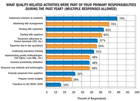
Despite the tales of economic woes and the disagreements as to whether or not the United States is in a recession, 94% of quality professionals find satisfaction in their jobs, according to Quality Magazine’s 8th Annual State of the Profession Survey. Nearly half of all quality professionals, 40%, claim their job satisfaction is highly satisfactory. This is a 2% increase over last year. Another 54% are moderately satisfied with their jobs.
For 45% of survey respondents, a feeling of accomplishment is the most important attribute in their job. This is followed by technical challenge for 39% and salary for one-third of respondents.

Salary
Again this year, annual salaries-including bonuses-continue to climb, to an average of $76,654. While only a 0.59% increase from last year, of the 67% of respondents who received an increase, the average increase was 5%. On par with the 2007 survey, 39% of this year’s respondents received an increase of 5% or more.On a bright note, 72% of respondents expect to receive an increase in their salary/compensation at their next performance review.
Salaries for quality professionals in the West were the highest at $83,518. For the first time, the survey took into account the average salary and bonus of quality professionals in California, which is an average of $94,033. With California removed from the equation, quality professionals in the West average a total compensation of $75,934, which is similar to the averages of the country’s other regions: the Northeast at an average of $77,775, the South with an average of $76,937 and the Midwest with an average of $74,704.
Just more than half of the 55% who received a cash bonus during the past year said it was an increase over last year’s bonus. Twenty-eight percent saw no change in the amount of their bonus, while 21% saw a decrease in their bonus.
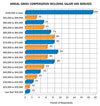
In a bit of a shift from last year, quality professionals in medical equipment and supplies manufacturing average the largest annual gross compensation at $88,005. This is followed by those involved in aerospace product/parts manufacturing, $83,827; navigation, measuring, electromedical and control instruments manufacturing, $82,971; machinery manufacturing, $80,478; and electrical equipment, appliance and component manufacturing, $79,882. Last year’s top category, computer and electronic manufacturing, fell to sixth place with annual compensation of $78,291, nearly a 19% decrease.
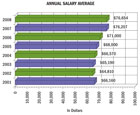

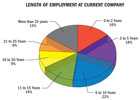

Challenges
Salary is not the biggest job concern on quality professionals’ minds. Rather it is a lack of management support that 40% of respondents say is their biggest concern. That is followed by economic conditions, 35%; job security, 32%; salary, 24%; and keeping current on technology, 20%.When asked what constraints or barriers will impact your job most during the next 12 months, 64% of respondents listed time constraints as the biggest barrier. This was followed by management support, 40%; dealing with customers and dealing with suppliers, 35% each; skilled labor shortage, 33%; budget cutbacks, 31%; and new and existing standards, 24%.

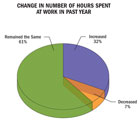
Quality Isn't Going Anywhere
Quality is here to stay. With numbers similar to last year, 47% of respondents have managed not to outsource their company’s production. Only 1% of the companies off-shores 100% of their production.During the next three years, 47% of quality professionals expect their companies to commit more resources toward improving quality operations. Forty-two percent expect their companies to commit the same amount of resources to improving quality, while only 11% expect to see fewer resources committed to quality during the next three years.

The increase in staff may be attributed to the fact that 35% of respondents said their companies are willing to be one of the early leaders when it comes to embracing quality technologies. Another 18% are willing to be on the leading edge. Thirty-four percent of companies take a wait-and-see approach and let other companies successfully implement quality technologies before implementing it themselves.

- Interfacing with management, 70%
- Dealing with customers, 64%
- Dealing with suppliers, 62%
- Document adherence to formal standards, 57%
- Supervising day-to-day operations, 56%
- Continuing education and training, 53%
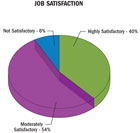

Taking into account the opportunities quality professionals have within their companies to develop their skills, company-paid benefits and annual compensation, quality professionals are still a happy lot.

Methodology
A total of 24,764 active, qualified Quality Magazine direct request subscribers were selected from the domestic (United States only) circulation with e-mail addresses whose job titles were management, manufacturing engineering, manufacturing/operations, quality/product assurance, engineering/technical, and research and development. These subscribers principle product manufactured includes: furniture and fixtures, rubber and miscellaneous plastic products, primary metal industries, fabricated metal products, nonelectronic machinery, electric and electronic equipment, transportation equipment and instruments and related products.